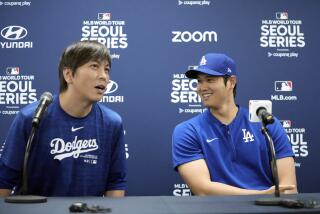SUPER BOWL : Drugs in NFL: Part History, Part Problem : Pro football: Many say the league’s program has made progress. Others say it’s naive to think the game is free of abuse.
- Share via
After about 6,000 drug tests this season, NFL officials were left with the impression that anabolic steroid use was subsiding. No roster player had failed a test, and those who had failed in training camps already had been cut for other reasons.
But when Eric Moore of the New York Giants and Mark Duckens of the Tampa Bay Buccaneers were indicted this month on federal charges of trafficking in and possessing anabolic steroids and human growth hormones (HGH), some suggested that steroid use had not decreased as much as the test results indicated.
Moore and Duckens, who have pleaded not guilty, are believed to be part of an international distribution operation, federal agents said. Whether the players were selling, or were planning to sell, to other players is not certain.
Drug Enforcement Administration officials who helped investigate the Moore and Duckens case have been careful not to speculate.
“We have no knowledge of imminent arrests of other NFL players,” said Illa Brown, the DEA’s public-information officer in Washington, D.C.
Still, the incident cast suspicions on a program that has become an NFL centerpiece. And to say that it has effectively stopped the use of performance-enhancing drugs might be premature, according to some experts.
But one point seems clear. Today’s program has greatly improved since it was under fire in 1989 for alleged irregularities.
“It is light years ahead of where they were before,” said Bill Fralic, an Atlanta Falcon guard and member of the league advisory committee on steroids.
“I think the players feel (drug advisers John Lombardo and Lawrence Brown) are ethical and they have confidence in them. I think the problem is a lot less severe than it was before.”
Three years ago, during the final year of Dr. Forest Tennant’s reign as football’s drug czar, the program was a public-relations headache.
“What the program lacked prior to Lombardo and Brown was credibility,” said Clark Gaines, regional director of the NFL Players Assn. “The players believe that the samples and procedures that they use (now) are valid and protect their right to privacy and individuality. They think confidentiality of this program is one thing they did not get from the Tennant program.”
Tennant’s program was hit by allegations from former employees and players who said the laboratory work was shoddy and that test results lacked accuracy. He was accused of ignoring the basic guidelines established by the National Institute on Drug Abuse.
Tennant resigned in March of 1990, although NFL officials and the West Covina physician steadfastly denied that the program was poorly run.
“I think a lot of the criticism leveled at Dr. Tennant was unfair,” said Jay Moyer, NFL executive vice president. “He was a pioneer and did a lot of good things. His heart was in the right place.”
Tennant, reflecting on the turmoil, said he was unprepared for the criticism but believes he did his best, under the circumstances.
He agrees that the NFL’s program has improved.
“I don’t know exactly what else they could do,” he said.
“They don’t need me anymore. It’s not like when we started in the old days. We were like one-armed paperhangers in the swamp with lots of alligators. We didn’t have the system set up. We didn’t have all the stuff that went around the testing technology . . . the collections, the administrative procedures, the help. In fact, I think that is really where most of the criticism centered.”
Tennant’s resignation three years ago ushered in a new era of NFL drug testing.
Instead of having one adviser handle the wide range of drugs available today, Commissioner Paul Tagliabue split the duties between Lombardo, chairman of family medicine at the Ohio State Medical School; and Brown, of the College of Physicians and Surgeons at Columbia University. Lombardo is a steroid expert, Brown a substance-abuse specialist.
Tagliabue, formerly the league’s general counsel, replaced Pete Rozelle as commissioner in 1989 with a mandate to rid the league of anabolic steroids.
League officials say the results of that commitment can be seen Sunday in the Rose Bowl when the Dallas Cowboys play the Buffalo Bills in Super Bowl XXVII. They are talking about a level playing field with drug-free players.
Although hard data are unavailable, many say players are not as bulky as five years ago. Fralic, the Falcon guard, said the younger players are big, but less muscular.
Robert Huizenga, formerly the Raiders’ team internist, said the consensus is that the players coming into winter camps are fatter, flabbier and smaller.
“It would certainly point to less (steroid) use in college,” he said. “I don’t know what that means for the pros.”
Anabolic steroids are synthetic derivatives of testosterone, the male sex hormone. They increase protein synthesis, which can increase lean muscle mass with training.
The human growth hormone is a genetically produced substance that in its original form is extracted from the pituitary glands of human cadavers. It also promotes muscle growth. The substances, if abused, are believed to cause side effects ranging from kidney, liver and heart ailments to severe acne.
When the league began testing for anabolic steroids in 1987, use was rampant. Tennant said officials were so concerned about eliminating the cocaine problem that steroid use was overlooked.
It is debatable, however, whether increasingly sophisticated testing or the resulting sanctions against those caught has inhibited players from using performance-enhancing agents. It has, though, inspired some to find more creative methods of beating the tests.
Players have taken masking agents, hidden clean bags of urine under their clothing when called upon to give a sample and had others leave clean specimens for them.
There is a cottage industry geared to beating drug tests. Besides masking agents, athletes use undetectable drugs such as HGH and what have become known as designer steroids--drugs that have the structural makeup of known steroids but have not been categorized as banned substances.
“I think you have a certain segment (who) will go to any length to beat something,” Lombardo, the steroid adviser, said. “Eradication of steroids? I don’t think I’d ever say anything is 100%. I’m not naive.”
Said Huizenga, a past president of the NFL’s Physicians Society, “The (players are) definitely getting smart.”
Whether that means they have stopped using because of health risks or aren’t getting caught because they can avoid detection is open to debate, Huizenga said.
“There is much less drug use in the league, but there is still drug use,” he said. “I think it has shifted to less detectable drugs. There are rampant rumors about the use of growth hormones, which is substantial, especially on several teams.”
Huizenga refused to name the teams.
Hormones have been a problem for toxicologists because they are difficult to distinguish beyond what is naturally produced. They all have the same chemical makeup. A screening test that can identify a banned steroid is unable to detect added hormones.
Tennant, the former drug adviser, said that, although inroads have been made into stopping steroid use, he believes the players are using low dosages of testosterone, clenbuterol and HGH. The situation is similar in Olympic events.
Dr. Donald Catlin, who directs UCLA’s International Olympic Committee-accredited testing facility, said testosterone abuse is the chief concern among officials. Catlin conducts about 15,000 screens a year for the NFL, U.S. Olympic Committee and the NCAA.
He said that research efforts are concentrating on finding better ways to detect artificial testosterone. Most athletes, he said, take testosterone in low dosages to avoid severe side effects and possible detection.
Said Lombardo, “It’s an ongoing cat-and-mouse game.”
And some experts wonder who really is winning, the athletes or the drug testers.
“We know use used to be tremendously high,” Huizenga said. “We have no idea what it is now. The penalties are so high we’ve pushed everything underground. Either we have (ended) the problem or we’ve pushed it underground. Who knows? How can somebody tell you?”
More to Read
Go beyond the scoreboard
Get the latest on L.A.'s teams in the daily Sports Report newsletter.
You may occasionally receive promotional content from the Los Angeles Times.










